AVEDEV function - The function returns the average absolute deviation of data points from their midpoint in Excel
The following article details in detail how to use AVEDEV function, the function of calculating the average of absolute deviation in Excel.

Description: The function returns the average absolute deviation between a given data point and the average value of the population. The function is a measure of the variability of a dataset.
Syntax: AVEDEV (number1, [number2], .) .
Inside:
- number1, number2, . : are the arguments to calculate the standard deviation, where number1 is the required parameter, the optional next parameters and the number of parameters is from 1 to 255 parameters.
Attention:
- AVEDEV function depends on the input data unit.
- The arguments must be a number, name or reference array that contains numeric values.
- If the parameter is a logical value or presents a number as a text you want to not be error, you should type directly into the list of arguments.
- Arguments that contain logical values, text, and blank cells are ignored, but cells with a value of 0 are still counted.
- Equation of AVEDEV function :

For example:
Evaluate students' level of subjects evenly by subject grades.

In the cell to calculate the absolute deviation between the subjects that enter the formula: = AVEDEV (E7: G7) .

Press Enter -> the absolute deviation result between 3 subjects of the student is:

Similarly copying the formula for the remaining data cells results:

Here the absolute difference between subjects is smaller, indicating that students learn very 3 subjects of math, physics, chemistry such as Hoang, Manh. The greater the absolute deviation, the more likely it is that she has not yet studied subjects like Hoang and Van Anh.
The above is a common usage and case of AVEDEV function .
Good luck!
You should read it
- COVARIANCE.P function - The function returns the covariance of a set, the product of the average of degrees of instruction for each pair of data points in Excel
- TRIMMEAN function - The function returns the average of the inner part of a dataset in Excel
- GEOMEAN function - The function returns the average of a positive array or range of data in Excel
- STDEV.P function - The function returns the standard deviation based on the whole in Excel
- STDEV.S function - The function returns the standard deviation based on a sample in Excel
- NORMDIST function - The function returns the normal distribution with the standard deviation and the average value specified in Excel
- How to use the DAVERAGE function in Excel
- HARMEAN function - The function returns the harmonic average of a data set in Excel
May be interested
- How to use NORMDIST function in Excel
 normdist is a function that returns a distribution with a standard deviation and a confirmed average. the normdist function applies in statistics, including hypothesis testing.
normdist is a function that returns a distribution with a standard deviation and a confirmed average. the normdist function applies in statistics, including hypothesis testing. - SKEW function - The function returns the deviation of the distribution in Excel
 skew function: the function returns the deviation of the distribution - the deviation represents the asymmetry of the distribution around its axis. - negative deviations: the distribution with the asymmetric side extends more to the negative value. - positive deviation: the distribution with the asymmetric side extends much to g
skew function: the function returns the deviation of the distribution - the deviation represents the asymmetry of the distribution around its axis. - negative deviations: the distribution with the asymmetric side extends more to the negative value. - positive deviation: the distribution with the asymmetric side extends much to g - How to use the NORMDIST function in Excel - Function that returns the distribution in Excel
 the normdist function returns a distribution with a specified mean and standard deviation. the normdist function has applications in statistics, including hypothesis testing.
the normdist function returns a distribution with a specified mean and standard deviation. the normdist function has applications in statistics, including hypothesis testing. - HARMEAN function - The function returns the harmonic average of a data set in Excel
 harmean function: the function returns the harmonic mean of a dataset, the harmonic mean is the reciprocal of the arithmetic mean of the reciprocals. syntax: harmean (number1, [number2], ...)
harmean function: the function returns the harmonic mean of a dataset, the harmonic mean is the reciprocal of the arithmetic mean of the reciprocals. syntax: harmean (number1, [number2], ...) - NORM.S.DIST function - The function returns the normalized distribution with a mean of 0 and a standard deviation of 1 in Excel
 norm.s.dist: the function returns the normalized distribution with a mean of 0 and a standard deviation of 1. use the function instead of a table containing standardized curve areas. support functions from excel 2010 onwards. syntax: norm.s.dist (z, cumulative)
norm.s.dist: the function returns the normalized distribution with a mean of 0 and a standard deviation of 1. use the function instead of a table containing standardized curve areas. support functions from excel 2010 onwards. syntax: norm.s.dist (z, cumulative) - NORM.DIST function - The function returns the normal distribution with the standard deviation and the mean value specified in Excel
 norm.dist: the function returns the normal distribution with a standard deviation and a defined mean. functions widely used in hypothesis testing statistics. support functions from excel 2010 onwards. syntax: norm.dist (x, mean, standard_dev, cumulative)
norm.dist: the function returns the normal distribution with a standard deviation and a defined mean. functions widely used in hypothesis testing statistics. support functions from excel 2010 onwards. syntax: norm.dist (x, mean, standard_dev, cumulative) - AVERAGE function - The function returns the average of the arguments in Excel
 average function: the function returns the average of the arguments. syntax: average (number1, [number2], ...)
average function: the function returns the average of the arguments. syntax: average (number1, [number2], ...) - FTEST function - The function returns the result of an F-Test in Excel
 the following article details how to use ftest - the function returns the result of an f-test. in statistical probability, the determination of the correctness and the deviation between two data samples is a regular and extremely important job.
the following article details how to use ftest - the function returns the result of an f-test. in statistical probability, the determination of the correctness and the deviation between two data samples is a regular and extremely important job. - How to use the DAVERAGE function in Excel
 daverage in excel is a function that calculates the average value of data with given conditions in a spreadsheet. so, how to use this function?
daverage in excel is a function that calculates the average value of data with given conditions in a spreadsheet. so, how to use this function? - SLOPE function - The function returns the slope of a linear regression line through data points in Excel
 slope function: the function returns the slope of a linear regression line through data points. the slope is the vertical distance divided by the horizontal distance between any two points on that line, the rate of change along the regression line. syntax: slope (known_ys, known_xs)
slope function: the function returns the slope of a linear regression line through data points. the slope is the vertical distance divided by the horizontal distance between any two points on that line, the rate of change along the regression line. syntax: slope (known_ys, known_xs)










 DATEVALUE function - The function converts dates into numbers in Excel
DATEVALUE function - The function converts dates into numbers in Excel The DAY function - The function returns the day of the day, month and year in Excel
The DAY function - The function returns the day of the day, month and year in Excel MINUTE function - The function converts a serial number into a minute in Excel
MINUTE function - The function converts a serial number into a minute in Excel MONTH function - The function converts a serial number into a month in Excel
MONTH function - The function converts a serial number into a month in Excel NOW function - The function returns the current date and time in Excel
NOW function - The function returns the current date and time in Excel Instructions on how to enter chemical formulas in Excel
Instructions on how to enter chemical formulas in Excel